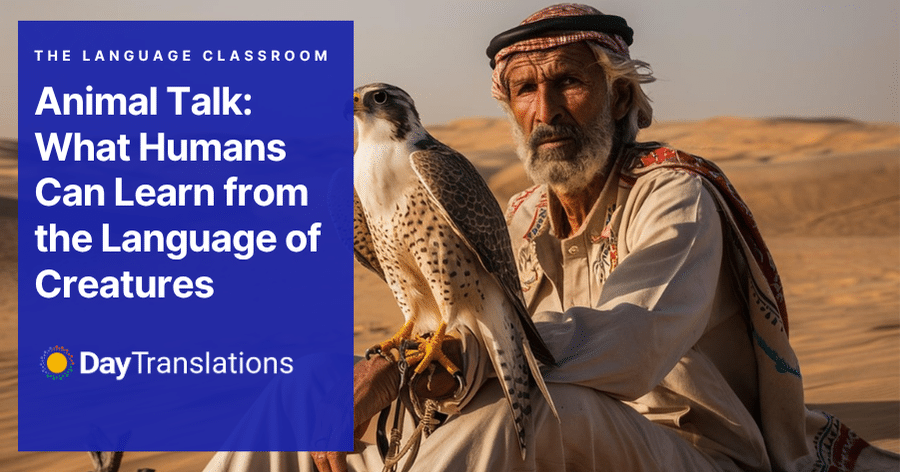Welcome back to The Language Classroom, where we explore the many fascinating ways humans use and understand language. But today, we’re venturing beyond the realm of human speech and text. We’re going wild—literally.
Language is typically thought of as a uniquely human trait. After all, we have grammar, syntax, dictionaries, and debate panels.
But communication? That’s a whole different story, and one that includes many of our fellow creatures.
From buzzing bees to singing whales, the animal kingdom is bursting with its own remarkable systems of expression. Some are visual, others vocal. Some are scent-based, some are seismic. But all of them offer powerful insights into how we humans communicate, and what we can still learn about the nature of language itself.
Let’s take a closer look at animals’ fascinating “languages” and what they can teach us about our own.
The Waggle Dance: Communicating Through Movement
One of the most famous examples of animal communication is the honeybee’s waggle dance. When a bee finds a rich source of nectar, it doesn’t just return to the hive and celebrate quietly. It performs a specific dance, moving in a figure-eight pattern, with a central waggle run that indicates the direction and distance of the food source relative to the sun.
This dance is not just instinctive motion; it’s a sophisticated form of symbolic communication. The angle of the dance conveys direction, while the duration of the waggle tells other bees how far they’ll need to fly. Foragers observe and interpret the performance, then head off in the indicated direction.
This shows us that language doesn’t have to be verbal, or even auditory, to be meaningful. In human terms, it reminds us of the value of nonverbal cues, body language, and symbolic gestures. Sometimes, a message is most effective when shown, not spoken.
Dolphin Dialects and Whistle Names
Dolphins are renowned for their intelligence, and their communication systems are among the most complex in the animal kingdom. They interact using various sounds, including clicks, whistles, and burst pulses. Intriguingly, researchers have discovered that each dolphin has a unique “signature whistle,” essentially a name that it responds to.
These whistles are learned and used consistently across time, functioning like identifiers in a social network. Dolphins even mimic the signature whistles of their friends and family members, often to call out or reconnect.
Even more fascinating is the evidence of regional dialects among dolphin pods. Different groups have slightly different ways of vocalising, just as humans do in various parts of the world. This highlights communication’s social and cultural role, even in the ocean. For us, it’s a reminder that names, accents, and personal styles of expression are fundamental to how we form identity and connection.
Elephant Infrasound: Whispering Across Miles
Unlike bees and dolphins, elephants often communicate in a register we can’t even hear. Their infrasound vocalisations, low-frequency rumbles below the threshold of human hearing, can travel several kilometres through the ground and air.
Elephants use these deep vibrations to stay in contact with their herds, warn each other of threats, and even coordinate movements over large distances. This long-range communication is vital to their social structures and survival in the wild.
For humans, the elephant’s use of infrasound reminds us that communication doesn’t have to be loud or immediate to be powerful. Think of how a well-timed silence, a distant memory, or an unspoken understanding can carry meaning across time and space.
The Songbird Symphony: Learning Through Imitation
Birdsong is one of the most beautiful and studied forms of animal communication. While all birds vocalise in some way, songbirds (or oscines) are exceptionally skilled. Their songs are not just instinctual; they’re learned. Young birds listen to adults, mimic their songs, and refine their own. Some species even engage in back-and-forth exchanges, essentially musical conversations.
Interestingly, birds often adapt their songs to fit their environments. Urban birds, for instance, may sing at higher pitches to be heard over traffic noise. Others change their songs seasonally, or adjust them to attract mates or warn of predators.
This mirrors aspects of human language acquisition. Like children learning to speak, birds learn through repetition, social interaction, and environmental feedback. It’s a compelling reminder that learning language, whether bird or human, isn’t just about memorising; it’s about listening, practicing, and connecting.
What Can Humans Learn from Animal Communication?
While animal communication isn’t language in the full human sense, there’s no complex grammar or abstract storytelling, the similarities are too striking to ignore. Animals use systems that:
- Name and identify individuals
- Describe locations and conditions
- Express emotion and intent
- Change over time and environment
- Are culturally transmitted
By studying animal communication, linguists and cognitive scientists gain deeper insight into the building blocks of language itself. But more importantly, it teaches us to be more attuned to the nonverbal, intuitive, and alternative modes of connection that often go unnoticed.
Language, broadly defined, is everywhere, whether it’s the waggle of a bee, the whisper of an elephant, or the whistle of a dolphin. And that should inspire us to be better listeners, not just to each other, but to the world around us.












Sorry, the comment form is closed at this time.